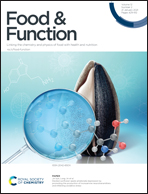Causal relations among starch fine molecular structure, lamellar/crystalline structure and in vitro digestion kinetics of native rice starch†
Abstract
Native rice starch is a source of slowly digestible starch in e.g. low-moisture baked products, while the molecular and lamellar/crystalline structure giving rise to this low-digestibility property is still largely unknown. In this study, the in vitro digestion kinetics of 11 rice starches with a wide range of amylose content were investigated. Applying the logarithm of slope (LOS) plot to the starch digestograms suggested that only a single first-order kinetics phase existed. More importantly, results for the first time showed that rice starches with shorter amylopectin short chains (DP 10–26) had more perfectly aligned crystalline lamellae and much slower digestion rates than the other starches. Interestingly, no correlations were found between the starch lamellar thicknesses with its digestion rate. It suggests that lamellar perfection plays a dominant role in the determination of native starch digestibility. Furthermore, starches with relatively shorter amylose short and medium chains showed a significantly higher amount of V-type amylose–lipid complex, and smaller maximum digestion extent. These results could help the rice industry develop a new generation of rice products with slower starch digestion rate and more desirable nutritional values.



 Please wait while we load your content...
Please wait while we load your content...